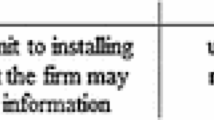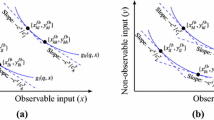Abstract
We consider the impact of bilateral unknown information about the market capacity on the optimal regulatory policies in a regulation problem. We first analyze how to solve such problem when the market capacity is full information, a case which allows us to obtain most of key insights from regulatory models. We then extend the analysis to the bilateral unknown information case. We do this by assuming that neither the regulator nor the firm knows exactly the true market capacity, but they can make respective estimates about it, the same or different. The results show that when the regulator and the firm make the same estimate about the true market capacity, the optimal price is distorted downwards from that under full information, and the transfer payment is distorted upwards from that under full information, but bilateral unknown information does not necessarily result in the distortion of the firm’s output. When the regulator and the firm make the different estimates about the true market capacity, and if the firm’s estimate is more optimistic than the regulator’s, the optimal price and output are more than those under the case that they have the same estimate. Contrary to this case, if the firm’s estimate is more pessimistic than the regulator’s, the optimal price and output are less than those under the case that they have the same estimate.




Similar content being viewed by others
References
Aguirre I (2004) Regulating a monopolist with unknown demand: costly public funds and the value of private information. Journal of Public Economic Theory 6(5):693–706
Armstrong M, Sappington D (2004) Toward a synthesis of models of regulatory policy design with limited information. J Regul Econ 26(1):5–21
Armstrong M, Sappington D (2005) Recent developments in the theory of regulation. In: Handbook of industrial organization, vol 3, pp 1557–1700
Babich V, Li H, Ritchken P, Wang Y (2012) Contracting with asymmetric demand information in supply chains. Eur J Oper Res 217(2):313–341
Baron D, Myerson R (1982) Regulating a monopolist with unknown costs. Econometrica 50(4):911–930
Baron D, Besanko D (1984) Regulating asymmetric information, and auditing. Rand J Econ 15(4):447–470
Botero J, Djankov S, Porta R, Silanes F, Shleifer A (2004) The regulation of labor. Q J Econ 119 (4):1339–1382
Ertek G, Griffin PM (2002) Supplier and buyer driven channels in a two-stage supply chain. IIE Trans 34 (8):691–700
Feng J, Lan Y, Zhao R (2017) Impact of price cap regulation on supply chain contracting between two monopolists. Journal of Industrial and Management Optimization 13(1):347–371
Georges A, David G (2012) Measuring the joint impact of governance form and economic regulation on airport efficiency. Eur J Oper Res 220(1):187–198
Griffin G (1972) The process analysis alternative to statistical cost functions: an application to petroleum refining. Am Econ Rev 62(1/2):46–56
Ha A, Zhang H, Tong S (2011) Sharing imperfect demand information in competing supply chains with production diseconomies. Manag Sci 57(3):566–581
Kurata H, Yao DQ, Liu JJ (2007) Pricing policies under direct vs. indirect channel competition and national vs. store brand competition. Eur J Oper Res 180(1):262–281
Kalai E, Kamien MI, Rubinovitch M (1992) Optimal service speeds in a competitive environment. Manag Sci 38(8):1154–1163
Laffont J, Tirole J (1986) Using cost observation to regulate firms. J Polit Econ 94(3):614–641
Laffont J, Rochet J (1998) Regulation of a risk averse firm. Games Econom Behav 25(2):149–173
Laffont J, Tirole J (1993) A theory of incentives in procurement and regulation. MIT Press, Cambridge
Laffont J, Mortimort D (2002) The theory of incentive: the principal-agent model. Princeton University Press, Princeton
Lau AHL, Lau HS, Zhou YW (2006) Considering asymmetrical manufacturing cost information in a two-echelon system that uses priceonly contracts. IIE Trans 38(3):253–271
Lewis T, Sappington DEM (1988a) Regulating a monopolist with unknown demand. Am Econ Rev 78 (5):986–998
Li T, Zhang H (2015) Information sharing in a supply chain with a make-to-stock manufacturer. Omega 50:115–125
Muthuraman K, Aouam T, Rardin R (2008) Regulation of natural gas distribution using policy benchmarks. Oper Res 56(5):1131–1145
Mollick A (2004) Production smoothing in the Japanese vehicle industry. Int J Prod Econ 91(1):63–74
Özer Ö, Raz G (2011) Supply chain sourcing under asymmetric information. Prod Oper Manag 20 (1):92–115
Porteus E (2002) Foundations of stochastic inventory theory. Stanford Business Books, California
Resende M (2008) Efficiency measurement and regulation in US telecommunications: a robustness analysis. Int J Prod Econ 114(1):205–218
Riordan M (1984) On delegating price authority to a regulated firm. Rand J Econ 15(1):108–115
Sappington D (1983) Optimal regulation of a multiproduct monopoly with unknown technological capabilities. Bell J Econ 14(2):453–463
Sappington D, Sibley D (1988) Regulating without cost information: the incremental surplus subsidy scheme. Int Econ Rev 29(2):297–306
Thanassoulis E (2000) DEA and its use in the regulation of water companies. Eur J Oper Res 127(1):1–13
Wu C, Li K, Shi T (2017) Supply chain coordination with two-part tariffs under information asymmetry. Int J Prod Econ 55(9):2575–2589
Yao DQ, Yue X, Liu JJ (2008) Vertical cost information sharing in a supply chain with value-adding retailers. Omega 36(5):838–851
Yang L, Ng CT (2014) Flexible capacity strategy with multiple market periods under demand uncertainty and investment constraint. Eur J Oper Res 236(2):511–521
Zeithammer R, Thomadsen R (2013) Vertical differentiation with variety-seeking consumers. Manag Sci 59 (2):390–401
Acknowledgements
This work was supported by the National Natural Science Foundation of China under Grant No. 71771166, Tianjin Natural Science Foundation under Grant No. 18JCQNJC04200, and partly by a S\(\hat {e}\)r Cymru II COFUND Fellowship, UK.
Author information
Authors and Affiliations
Corresponding author
Additional information
Publisher’s note
Springer Nature remains neutral with regard to jurisdictional claims in published maps and institutional affiliations.
Appendix
Appendix
Proof Proof of Theorem 1.
The constraint of Model (4) is binding at the optimum; otherwise, the regulator can decrease t until it binds, i.e., π(p,t,y) = 0. Therefore, the regulator allocates all surplus to the consumer. By π(p,t,y) = 0, we can obtain
Substituting t into the objective function of Model (4) yields
By \(V^{\prime \prime }(\cdot )\leq 0\) and \(C^{\prime \prime }(\cdot )>0\), we obtain W(p,t,y) is concave with respect to p. Therefore, the optimal price p∗ satisfies the first-order condition
The optimal output q∗ follows q∗ = y − bp∗ from Eq. 25. It also follows from Eq. 23 that t∗ = C(y − bp) − p(y − bp). The proof is complete. □
Proof Proof of Theorem 2.
We firstly verify that the objective function (13) is jointly concave with respect to (p,q). The first-order and second-order partial derivatives of E[W(p,q,Y )] with respect to (p,q) can be shown as
By Eqs. 26, 27 and 28, the Hessian matrix
It follows from \(V^{\prime }(\cdot )>0\) and \(V^{\prime \prime }(\cdot )\leq 0\) that \(\frac {\partial ^{2}{E[W(p,q,Y)]}}{\partial {p^{2}}}<0\), \(\frac {\partial ^{2}{E[W(p,q,Y)]}}{\partial {q^{2}}}<0\), \(\left |H\right |=b^{2}V^{\prime }F^{\prime }C^{\prime \prime }>0\), i.e., H is negative definite, thus E[W(p,q,Y )] is jointly concave with respect to (p,q).
Therefore, the optimal price \(p_{1}^{*}\) and the optimal output \(q_{1}^{*}\) satisfy
It follows from Eq. 29 that \(p_{1}^{*}=\frac {1}{b}(\underline {y}-q_{1}^{*})\) and \(V^{\prime }(q_{1}^{*})=C^{\prime }(q_{1}^{*})\). Thus, the proof of Theorem 4 is complete. □
Proof Proof of Proposition 1.
It follows from Eq. 5 that \(V^{\prime }(q^{*})=C^{\prime }(q^{*})\), together with Eq. 15 and \(C^{\prime \prime }>0\), we can obtain \(q_{1}^{*}=q^{*}\). Note that \(p_{1}^{*}=\underline {y}-bq_{1}^{*}\) and p∗ = y − bq∗, due to \({y}\geq {\underline {y}}\), it is clear that \(p_{1}^{*}\leq p^{*}\). Comparing Eq. 7 with Eq. 16, applying \(p_{1}^{*}\leq p^{*}\) and \(q_{1}^{*}=q^{*}\), we find immediately \(t_{1}^{*}\geq t^{*}\). The proof is complete. □
Proof Proof of Corollary 1.
It follows from Eq. 24 that
i.e.,
and by Eq. 13, we know
By Eq. 17\(q^{*}=q_{1}^{*}\), together with \(V^{\prime }>0\), comparing Eq. 30 with Eq. 31, it is clear that \(E[W^{*}(p^{*},q^{*},t^{*})]\geq E[W_{1}^{*}(p_{1}^{*},q_{1}^{*},t_{1}^{*})]\). The proof of Corollary 1 is complete. □
Proof Proof of Proposition 2.
For the regulator’s objective function (22), if the optimal price \(p_{2}^{*}\) exists, it should satisfy the first-order condition
It follows from Eq. 29 that \(p_{1}^{*}\) satisfies
To compare \(p_{2}^{*}\) and \(p_{1}^{*}\), let
By \(V^{\prime }>0\), \(V^{\prime \prime }\leq 0\) and \(F_{1}^{\prime }>0\), differentiating K(p) with respect to p yields
Therefore, K(p) is increasing with respect to p. Comparing Eq. 32 with Eq. 33, we can obtain \(p_{2}^{*}>p_{1}^{*}\) when F1(y) > F2(y). Correspondingly, \(p_{2}^{*}<p_{1}^{*}\) holds when F1(y) < F2(y).
Similarly, if the optimal output \(q_{2}^{*}\) exists, it should satisfy the first-order condition
It follows from Eq. 29 that \(q_{1}^{*}\) satisfies
To compare \(q_{2}^{*}\) with \(q_{1}^{*}\), let
By \(V^{\prime }>0\), \(V^{\prime \prime }\leq 0\) and \(C^{\prime \prime }>0\), and differentiating with respect to q yields
Hence, H(q) is decreasing with respect to q. Comparing Eq. 34 with Eq. 35, we can obtain \(q_{2}^{*}>q_{1}^{*}\) when F1(y) > F2(y). Correspondingly, when F1(y) < F2(y), \(q_{2}^{*}<q_{1}^{*}\) holds. The proof of Proposition 2 is complete. □
Lemma 1
Both the optimal price \(p_{2}^{*}\) and the optimal output \(q_{2}^{*}\) are increasing with respect to \(\left [F_{1}(\cdot )-F_{2}(\cdot )\right ]\). In particular, \(p_{2}^{*}\) and \(q_{2}^{*}\) are down to minimum or up to maximum at F1(⋅) = F2(⋅), i.e., \(p_{2}^{*}=p_{1}^{*}\), \(q_{2}^{*}=q_{1}^{*}\).
Proof Proof of Proposition 3.
Similar to the proof of Proposition 2, it is easy to verify \(p_{2}^{*}= p_{1}^{*}\) and \(q_{2}^{*}= q_{1}^{*}\). By Eqs. 12 and 21, together with \(p_{2}^{*}= p_{1}^{*}\) and \(q_{2}^{*}= q_{1}^{*}\), we can obtain \(t_{1}^{*}>t_{2}^{*}\) when F1(y) > F2(y), and \(t_{1}^{*}<t_{2}^{*}\) when F1(y) < F2(y), respectively. The proof of Proposition 3 is complete. □
Rights and permissions
About this article
Cite this article
Feng, J., Lan, Y. Regulating a firm with bilateral unknown demands. J. of Data, Inf. and Manag. 1, 117–128 (2019). https://doi.org/10.1007/s42488-019-00011-0
Received:
Accepted:
Published:
Issue Date:
DOI: https://doi.org/10.1007/s42488-019-00011-0




